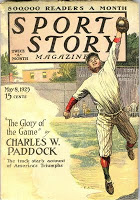A SHADOW OF A SNEAK PEEK
Black Coat Press shared a sneak peek at the upcoming In The Shadow of Judex release edited by Jean-Marc and Randy Lofficier with All Pulp.
Coming soon.
Stay tuned for more information as it becomes available.
Black Coat Press shared a sneak peek at the upcoming In The Shadow of Judex release edited by Jean-Marc and Randy Lofficier with All Pulp.
Coming soon.
Stay tuned for more information as it becomes available.
On their Facebook page, Seven Realms Publishing offered a peek at the brand new cover for New Pulp Author Sean Ellis‘ FORTUNE FAVORS (A Nick Kismet Adventure)
Coming May 2013!
Titan Books has revealed the cover the reissue of Philip José Farmer‘s FLESH!
Coming from Titan Books August 2013!
AVAILABLE NOW: FIGHT FICTIONEERS MAGAZINE VOLUME 2!
CELEBRATING THE BEST IN FIGHT FICTION . . .
PRESS RELEASE:
FOR YOUR FREE COPY OF THIS ACTION PACKED E-ZINE SEND AN EMAIL REQUEST TO: fightcardseries@gmail.com
Fight Fictioneers Magazine (FFM) is a vehicle for both promoting the Fight Card series and also the best fight fiction in general. Immense thanks are due to our Fight Card team member in Australia, David Foster (Fight Card: King Of The Outback), for his hard work and diligence in formatting and bringing this issue of FFM into the virtual world (as he did with Vol 1).
Hopefully, there will be another issue to kick off the new year as we march into 2013 with the Fight Card banner held high. FFM Vol 2 will be made available for free to anyone who asks for a copy, so please distribute copies to your friends and fans. Any feedback would also be appreciated …
Fight Fictioneers Magazine Volume 1 can still be accessed under the Fight Fictioneers tab on the new Fight Card website (www.fightcardbooks.com). Thx to author and Fight Card team member Jeremy Brown for his efforts in creating and maintaining the Fight Card website.
Upcoming Fight Card releases through the end of the year include Fight Card: Golden Gate Gloves (October – Robert Evans), Fight Card: The Knockout (November – Robert Randisi), and our second internationally set Fight Card tale (following Fight Card: King Of The Outback), Fight Card: Irish Dukes (December – Mike Faricy). Covers can be found on the Fight Card website www.fightcardbooks.com.
Congratulations to Fight Card authors Mel Odom (Omega Blue), Eric Beetner (The Devil Doesn’t Want Me), Heath Lowrance (City Of Heretics), Mike Faricy (Bombshell), and David Foster (The Librio Defection / Bushwhacked – both under his James Hopewood pseudonym), among others for the successful launching of new critically acclaimed titles – all available on Amazon. Way to go, gang!
There are other specific plans afoot for Fight Card in 2013, which I will reveal both as they firm up and as I am allowed to talk specifics.
THX TO ALL THE FIGHT CARD FANS WHO HAVE SUPPORTED THE SERIES THIS YEAR …
For those who missed it, you can also request a copy of Fight Fictioneers #1 as well. Email fightcardseries@gmail.com for details.
New Pulp Author Bobby Nash is the guest blogger over at author Rachel Hunter’s Life Defined blog today. Bobby tackles an issue he faced recently, creating a compelling novel cover. He goes through the steps it took to create the cover to his latest thriller, Deadly Games!
You can read the entire post at http://rachel-m-hunter.blogspot.com/2012/04/guest-post-judging-book-by-bobby-nash.html
 Thank goodness the wicked Helen did not bring about the end of mankind and civilization as we knew it. This meant the characters of ITV’s Primeval could come back for a fresh go-round. The show took a breather after the third season ended in 2009 and came back in seven and six episode arcs, making for abbreviated fourth and fifth seasons respectively and they are now available as a combined third volume in either standard DVD or, for the first time, as a Blu-ray option from BBC Video.
Thank goodness the wicked Helen did not bring about the end of mankind and civilization as we knew it. This meant the characters of ITV’s Primeval could come back for a fresh go-round. The show took a breather after the third season ended in 2009 and came back in seven and six episode arcs, making for abbreviated fourth and fifth seasons respectively and they are now available as a combined third volume in either standard DVD or, for the first time, as a Blu-ray option from BBC Video.
I find myself enjoying the series more for the characters than the writing, which either leaves holes as big as the anomalies the heroes deal with or are overly convoluted, leaving me wishing for a happy middle ground.
 Season three ended with three of our heroes – Connor Temple (Andrew Lee Potts), Abby Maitland (Hannah Spearritt), and Danny Quinn (Jason Flemyng) – trapped in different eras of the past while life back at the ARC continued, presuming them lost but not dead. Still, the near destruction of reality meant a rethinking of the operation which allowed the creators – Adrian Hodges and Tim Haines – to retool the show a bit, mostly for the better. (more…)
Season three ended with three of our heroes – Connor Temple (Andrew Lee Potts), Abby Maitland (Hannah Spearritt), and Danny Quinn (Jason Flemyng) – trapped in different eras of the past while life back at the ARC continued, presuming them lost but not dead. Still, the near destruction of reality meant a rethinking of the operation which allowed the creators – Adrian Hodges and Tim Haines – to retool the show a bit, mostly for the better. (more…)
 With all the attention paid to the flashy artists of the moment at the major publishers, it’s always refreshing to see that the talented and reliable artists also get their due. Flesh Publications can usually be counted on for classy packages featuting artists who deserve your attention even if they don’t illustrate your favorite monthly titles. Check out this new announcement:
With all the attention paid to the flashy artists of the moment at the major publishers, it’s always refreshing to see that the talented and reliable artists also get their due. Flesh Publications can usually be counted on for classy packages featuting artists who deserve your attention even if they don’t illustrate your favorite monthly titles. Check out this new announcement:
Flesk Publications is proud to announce their latest art book, Flesk Prime.
Flesk Prime serves as a fresh look into the imagery of five exceptional artists: Craig Elliott, Gary Gianni, Petar Meseldzija, Mark Schultz and William Stout. The essence of each craftsman is captured here to satisfy their fans as well as individuals who are enjoying their first glimpse. The section on each artist begins with an introduction and a biography written by Flesk publisher John Fleskes. The five were invited to handpick their pieces for inclusion, to showcase the best representation of their works.
Furthermore, new quotes have been obtained to capture the artists’ own thoughts. Each chapter shows the dynamic range of styles and illustrations and the unique diversity of these five creators. Almost all of the artwork has been reproduced direct from the originals.
Flesk Prime is a full-color 64 page hardbound book with jacket at 8.5 x 11 inches. The cover price is $24.95. ISBN: 978-1-933865-38-6. Pre-orders are being accepted at the Flesk online store. The book will premiere at Comic-Con International in San Diego at the Flesk booth (#5019) on July 20. There you can have Elliott, Gianni, Schultz and Stout sign your copy. All pre-orders will begin shipping on July 26. This title is an exclusive item only available direct from Flesk Publications.
Elliott’s section contains an assortment of fine art, much of it centered on the female form. Also featured are editorial assignments and an enlightening look into the process behind one of his most recent paintings.
Gianni is represented by oil paintings, a pencil sketch, finished pen-and-ink drawings, comic book pages, a Sunday newspaper strip and book illustrations that span the last twenty years. (more…)

Marvel announced these a while back, but it seems more appropriate to show you these on Flag Day: to promote Captain America: The First Avenger, Marvel is running “I Am Captain America” variant covers on selected titles through June and July, with all-new artwork from Joe Quesada, Marko Djurdjevic, Alex Maleev, Skottie Young, and Ed McGuiness, among others.
Personally, I’d love to have a few of these as posters.